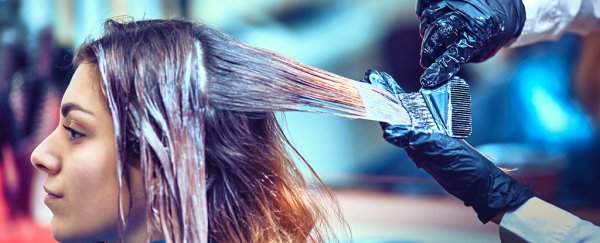A new study reported this week claims that of the thousands of ingredients that go into hair products used to dye and straighten our hair, some might play a role in kick-starting breast cancer in women already at risk. But before you panic and throw out your box dye, there are a few things we need to explain here.
"Researchers have been studying the possible link between hair dye and cancer for a long time, but results have been inconsistent," says one of the study authors, epidemiologist Alexandra White from the National Institute of Environmental Health Sciences (NIEHS).
In this case, the researchers went looking amongst a cohort of people who have breast cancer in the family - so ones who are already in a higher risk group.
Among nearly 47,000 women with sisters diagnosed with breast cancer, researchers from NIEHS and the University of North Carolina identified a significant increase in incidences of the disease among those who dyed or straightened their hair frequently.
The possibility of such an association isn't exactly new, having been scrutinised in the past. But, as is often the case with potential health risks, research hasn't provided a clear answer - and any correlational effects are often quite small.
But the fact that hair products are amongst the many sources of potential endocrine disruptors and carcinogens in our environment has warranted researchers to go on the hunt for links to nasty health effects.
Some recent studies have indicated that use of dark hair dyes and straightening agents has been linked to the chances of developing breast cancer. But with some epidemiological studies finding no hint of an association, it's a topic that is yet to be satisfactorily resolved.
The NIEHS' Sister Study provided an ideal opportunity for researchers to return to the question, this time armed with a larger sample. Participants came from different backgrounds all across the US and Puerto Rico, and responded to a questionnaire that includes information on the frequency of use of hair products.
Nearly one in ten of the participants identified as African American, allowing researchers to break down the sample into different racial groups.
Among the participants who identified as white and who used a permanent hair dye at least once every five to eight weeks, there was an 8 percent greater risk in later developing breast cancer, compared with those who didn't use hair products.
For those who identified as African American and also regularly used hair dyes, the jump was far greater, up to 60 percent. When it came to hair straighteners, there was no clear distinction between the racial groups, there was still a noticeable effect, according to the researchers.
Using a straightening product at least once every couple of months made it 30 percent more likely that a participant would develop breast cancer, regardless of whether they were white, African American, or Hispanic.
But to even begin to make sense of the statistics, we need to look behind the results and include some other numbers. All of these percentages reflect relative, not absolute risk. As we have explained before when reporting on association studies:
"Relative risk means how much more likely one group is to develop a disease in comparison to another (..).
Meanwhile, absolute risk is the one that tells you how likely you are to get a disease at all."
That absolute risk is usually a really, really small number. In this case, none of the women in the study had a prior diagnosis of breast cancer. But since the people in the database all had a family member with breast cancer, their risk of developing the disease was already above that of the general population.
A 2008 study conducted on more than 23,000 Swedish women with sisters diagnosed with breast cancer found they were between 2 and 6.5 times more likely to develop the disease at some point in their life, compared with the rest of the community.
For perspective, across the US about 1 in 8 women will develop an invasive breast tumour over their lifetime. Even among that broad range of people, there are sub groups who are at greater and lesser risk, depending on factors such as body mass, family history, and age.
Added all together, translating one study into a word of advice for any one individual is impossible. Science simply doesn't work that way, and for relatively small jumps in risk like this, it's even harder to argue how we might want to change our habits.
In this case, the precise cause for the difference in relative cancer risk – or even whether the link is causal – is impossible to say based on the results alone. We might speculate based on how different groups use hair products, not to mention contrasting quality of healthcare.
Based on this and previous research, it's still possible there is something going on with exposure to hair dye chemicals, but this is not the definite proof you'd need to make that claim.
Even the researchers admit that the study, while noteworthy, must be taken in greater context.
"We are exposed to many things that could potentially contribute to breast cancer, and it is unlikely that any single factor explains a woman's risk," says researcher Dale Sandler, chief of the NIEHS Epidemiology Branch.
So, if you are concerned about your personal breast cancer risk, it's always best to just talk to your doctor about it, and not worry too much about scary headlines.
This research was published in the International Journal of Cancer.
